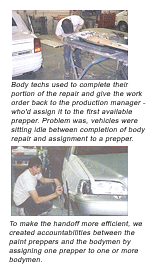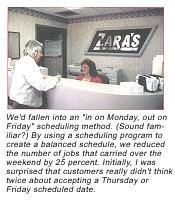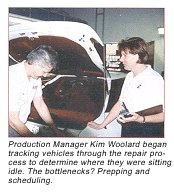For several years, I’d been hearing about the importance of cycle time for collision repair centers. It was a topic of conversation at my paint company performance group meetings. Insurance executives talked about their desire for faster repairs in reducing claims severity, and some insurance companies even developed incentives for collision repair shops that reduced cycle times. Industry publications began writing articles. Consultants outlined the benefits for collision repair centers, insurance companies and vehicle owners.
The topic seemed to be everywhere.
So we here at Zara’s Collision Center did the only sensible thing – we began to consider how to improve our cycle times. Since then, we’ve shaved nearly two days off our average repair time.
How? By:
- Measuring cycle time.
- Identifying bottlenecks and implementing solutions (which included improving our scheduling process).
At the same time, we weren’t fooled by the four common cycle time myths:
Myth No. 1: Most shops accurately estimate the amount of work they can complete on a job in a day.
Myth No. 2: Efficient technicians are the key to improving cycle time.
Myth No. 3: Customers won’t schedule their vehicles to be dropped off for repairs late in the week.
Myth No. 4: Scheduling throughout the week will lead to more vehicles being tied up over the weekends.
Let’s Take A Closer Look …Defining What Cycle Time Means to You
To improve our cycle time, we needed to know what it was. The performance groups we attended spent a significant amount of time trying to define cycle time.
We asked: “When does cycle time start? At the time of the accident? When the insurance company is notified of the claim? When the vehicle is dropped off at the collision repair center? When the collision repair center receives authorization to repair the vehicle? When the collision repair center begins the repairs?”
We also asked: “When does cycle time end? When the repairs are completed? When the customer picks up the repaired vehicle? When all of the money for the repair is collected? When the claim is closed-out by the insurance company?”
Ultimately, we acknowledged that the beginning and ending points for cycle time depend upon the vantage point from which we’re looking. Insurance companies, vehicle owners and collision repair centers could all have a different interpretation of “cycle time.”
Without an industry standard, we were free to choose our own definition and to even change it later if we came up with a better definition for our store. It also meant that we couldn’t assume that others would understand what we meant by “cycle time” unless we communicated our definition clearly.
At Zara’s, we decided cycle time would be from drop-off to delivery– from when customers dropped off their vehicle until they picked it up again. That would be our definition of cycle time.
New Definition: Hours Per Repair Order
Through our performance group, we began reporting our cycle time as the average number of days from drop-off to delivery. Unfortunately, we were unable to compare our performance with other stores when their average repair order size differed significantly from ours. Even more troubling was our inability to compare our performance from one month to the next when our own average repair order varied.
Instead, we began to measure cycle time as the average number of hours produced each day on each job. That’s a mouthful. But it’s also a concept that most shops are already familiar with and use. Here’s how:
When an estimator is asked how long a repair will take, he commonly divides the number of hours on the estimate by four or five hours to determine how many days the repairs will take. In this example, the four- or five-hour figure is really an estimate of how many hours are produced each day on each job.

This is where our first myth comes into play:
– Myth No. 1: Most shops accurately estimate the amount of work they can complete on a job in a day.
Think again. In my performance group, the average number of hours produced per repair order (RO) per day was less than three. And based on my discussions with shop owners in other performance groups and with consultants who work with shops to measure this, three hours produced per RO per day seems commonplace.
There’s also another problem with this process used to estimate the number of days required for a repair. The process only considers the hours on the estimate. But in many shops, supplements may average 20 percent or more of the original estimate. By ignoring the potential supplements, estimators may significantly underestimate the repair time required. This leads to over-promising and under-delivering– not a good combination.
Still, the “hours produced per RO per day” measurement allows for better comparisons of cycle times, whether between stores or for a single store over time. If we could determine the correct numbers to be used in this measurement, we could compare our cycle time against other stores and also against our own previous performance to see if we were improving.
To refine our numbers, we began computing the average hours produced each day on each RO for our most significant sources of business, including insurance companies and dealerships. This allowed us to see if our cycle times were actually better on our DRP vs. our non-DRP work and to see if our cycle times were improving over time with individual companies. We also measured cycle time by size of job and identified a trend for this average to increase in our store as the size of the job increased.
Because these calculations weren’t available through our management system, we worked with our consultant Kent Carlson of Collision Resources to develop an Excel spreadsheet that would perform these calculations for us.
What did we learn from these measurements? Our cycle time was in line with the rest of our performance group– averaging only 2.7 hours per RO per day.
Idle Cars Cost You
Very simply, you improve cycle time by reducing the time a vehicle sits without being worked on.
To identify where vehicles were sitting idle at Zara’s, we had our production manager, Kim Woolard, begin tracking vehicles through the repair process. In less than two weeks, we’d identified two steps in the process where vehicles were hung up: prepping and scheduling.
- Prepping– In our store, we have multiple body technicians feeding work to multiple preppers. The body technician would complete his portion of the repair and hand the work order back in to the production manager– who’d assign it to the first available paint prepper.

We discovered quickly that there was a major gap in the capacity of our body and paint departments. Vehicles were sitting idle, sometimes for days, between completion of body repair and assignment to a prepper. The small jobs would get forced in before larger jobs, and it wasn’t uncommon for a body technician to get three or four vehicles back for reassembly at the same time.
We determined the handoff could be done much more efficiently by creating accountabilities between the preppers and the bodymen. Rather than having the bodymen feed the prepping department, we now assigned a prepper to one or more bodymen. And that prepper was responsible for performing the prep work on the vehicles sent over by his bodymen.
This simple change provided numerous benefits that helped to improve cycle times. First, no time was lost in waiting for the production manager to assign a job to a prepper. Second, the preppers could now begin to plan their days better. By communicating with the bodyman who he was accountable to, the prepper could anticipate when work would be coming over and what that work would entail. Third, by pairing up a prepper with metal technicians, some peer pressure was applied to keep up and to produce at higher levels.
- Scheduling– In our analysis, we determined that the greatest single opportunity to improve our cycle time lay in our ability to get the right amount of work and a good mix of work to our door on a daily basis. Because we’d have too much work show up at once, we were consistently having numerous jobs sit idle for one or even two days before they’d be assigned to a technician.
Enter our second myth:
– Myth No. 2: Efficient technicians are the key to improving cycle time.
Some stores with very efficient technicians may actually have poor cycle times, and other stores improve the efficiency of technicians by having so much work on hand that the techs never run out of work. But if each technician has four or five vehicles in process at once, then three or four are sitting idle at any given time. Even an efficient technician can only work on one vehicle at a time.
This scenario may result in high employee efficiencies, but poor cycle times. Not to mention the fact that valuable shop space becomes storage for idle jobs.
Through the years, we’d attempted to address this improper workflow with refinements to our paper-based scheduling system. Previously, we’d attempted to balance the vehicles being dropped off for repairs by designating slots for drop offs each weekday. And after a run of heavy hits slowed the workflow, we also tried to balance the hours when jobs were being dropped off each day. Next, due to ongoing fluctuations with work-in-progress, we added slots for the delivery of vehicles back to customers. A repair job would be scheduled both in and out of the facility.
Each of these attempts at refining the schedule was valid. However, they required a great deal of the estimator’s time to perform the calculations and to identify the scheduling options. They also drew the estimator’s focus away from selling the repair and from the customer.
Ultimately, when things got busy, we’d fall away from using the systems consistently. We’d force 13 or 14 jobs into Monday’s seven or eight drop-off slots, while Thursday’s and Friday’s drop-off slots went virtually unused. Essentially, we fell into an “in on Monday, out on Friday” scheduling method. While easy to implement, this approach to scheduling isn’t conducive to a smooth workflow.
Which brings out to our next myth:
– Myth No. 3: Customers won’t schedule their vehicles to be dropped off for repairs late in the week.
Most customers haven’t had a need to utilize a collision repair facility for more than five years. Because they generally don’t know what to expect from the process, it’s up to the collision repair center to educate the customer about how it all works.
We provide the customer with several scheduling options. Generally, customers accept this as the way the process works and agree to drop off vehicles for repairs late in the week.

Because I knew the paper-based scheduling systems weren’t going to be sufficient to ensure that we’d have the right volume and mix of work, we again turned to Kent Carlson– who created for us an easy-to-use, automated system to balance our workflow.
He provided us with the scheduling program CR Auto Scheduler. Among other things, the program returns scheduling options for each repair that balance the vehicles in and out of the facility and the hours into the facility throughout the week. By automating the system, we’ve been able to consistently implement our scheduling process.
Time to debunk the fourth and final myth:
– Myth No. 4: Scheduling throughout the week will lead to more vehicles being tied up over the weekends.
Not so. When we were able to consistently create a balanced schedule through the use of the scheduling program, we saw a 25 percent reduction in the number of jobs that carried over the weekend.
Where Do We Go From Here?
he results from implementing this program have been remarkable. We’ve proven that when the work is available, we’ve been able to increase our sales by using this method. Unfortunately, our market has been very soft for quite a while now so I don’t have any long-term increases to share with you. What I can tell you is that the scheduling system has saved me from making a large investment in a building addition to house the many idle vehicles. When you walk through our shop now, it looks empty compared to the pre-cycle time focus– yet we’re still doing the same or higher volume. I like to use the analogy that we used to be like a 4-cylinder engine going 100 mph, and now we’re a V8 just cruising along. There’s also been a reduction in the stress level since most jobs are completed ahead of schedule instead of running behind.
But we’re not done yet.
We’re going to continue to identify and minimize the gaps in our repair process that result in a vehicle sitting idle. We’re getting ready to address a couple of areas that have shown to be the next problem. We need to improve on the verification of parts as soon as the vehicle comes in for repair. Currently, there are too many times when a tech finds that he has a wrong part on the day the vehicle is to be done. We also need to improve our supplement process to try to get everything on one supplemental parts order when possible.
We still have much room for improvement. At the same time, we’ve also come a long way.
Based on our experiences and results, I’d encourage you to take some of the same initial steps that we took. The results just might surprise you. Writer Brad Zara is the owner of Zara’s Collision Center in Springfield, Ill. He can be reached at [email protected].
|
1. Most shops accurately estimate the amount of work they can complete on a job in a day. 2. Efficient technicians are the key to improving cycle time. 3. Customers won’t schedule their vehicles to be dropped off for repairs late in the week. 4. Scheduling throughout the week will lead to more vehicles being tied up over the weekends. |













